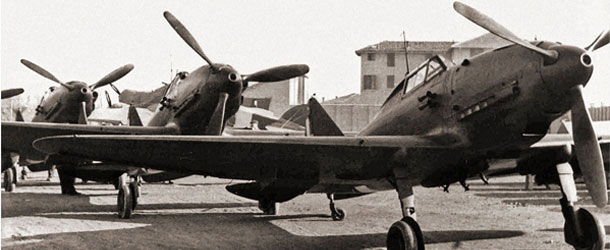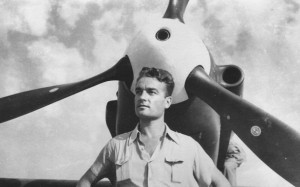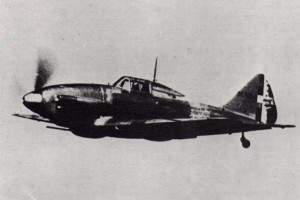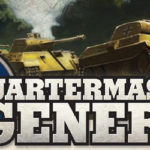The fourth aircraft of the upcoming Wings of Glory WW2 airplane packs to be presented in this preview series is the Reggiane Re.2001 Falco II – the previous articles featured the Curtiss P-40 Warhawk, Yakovlev Yak-1 and the Kawasaki Ki-61.
The Reggiane Re.2001 was an Italian fighter designed to overcome the weaknesses of the Re.2000. Intended to be an interceptor, the Re.2001 proved to be flexible and became also a fighter-bomber and night fighter.
At the beginning of the 20th century, Italy was at the forefront of aerial warfare, but during the WW2 the situation had changed. At the outbreak of war, in September 1939, the Italian Air Force was the smallest among the three major Axis nations and the fascist government held onto the dominant belief in the agility of biplanes, even after they had proven ineffective, and was not pursuing properly the development of aircrafts with better engine performance and firepower.
So, the Italian Air Force entered the war in numerical inferiority and ill-equipped to fight aerial battles.
The Reggiane Re.2001 was an all-wood fighter plane, a development of the Re.2000 Falco I, which despite the excellent design, was underpowered. The new model was equipped with an in-line engine - a 1,175 hp Alfa Romeo (license-built German DB 601), rather than a 986 hp Piaggio P.IX radial engine that provided a top speed of only 529 km/h (328 mph). But the change had little impact. The Re.2001's performance was hardly improved - , its maximum speed was just 542 km/h (336 mph).
Generally slower than contemporary fighters, the Reggiane Re.2001’s maneuverability allowed it to dogfight with more powerful opponents, as the Supermarine Spitfire. At lower and medium altitudes the Re.2001 was able to hold its own, but above 7,000 m (23,000 ft), the Spitfire clearly had a speed advantage. Against the Hawker Hurricane, the Re.2001 fared better and could take on this opponent on a more equal basis, although the type was noticeably slower at most altitudes.
The new Falco II was considered equal by most experts with the Macchi MC.202, but the Macchi fighter, having first call on production for the Alfa Romeo R.A.1000RC.41-1a (the license built DB 601) was still produced in greater numbers. Delayed by the wing redesign required by the Regia Aeronautica to have fuel tanks being placed inside them, and by production delays, the first production aircraft were finally cleared for operational use in June 1941, nearly a year behind schedule.
Only 252 Reggiane Re.2001 were produced in total, including variants. Two main variants were also developed to suit specialized roles: the Re.2001 CB (CacciaBombardiere, Fighter-bomber), produced from 1942, which could carry a 100 or 250 kg bomb under the fuselage for the attack role; and the CN (Caccia Notturno, night fighter) version, adapted with the introduction of engine exhaust-flame dampers and a 20 mm Mauser MG 151/20 cannon in two gondolas, one under each wing, although many fighters retained the original armament.
Three squadrons first received the Re.2001s in December 1941, but due to technical reasons the unit was not fully equipped and trained until February 1942. The first operation was over Malta in 1942, flying escort missions over Malta and the first encounter with the British Spitfire Mk Vs took place on 12 May, when 15 Reggiane Re.2001 of 2o Gruppo escorting (with Macchi MC.200s) three S.84 of 4o Gruppo were attacked by nine Spitfires. The British fighters shot down a bomber and badly damaged the other. The Reggiane pilots claimed two Spitfires and one pilot, Sergeant Charles Graysmark of 601 Squadron was killed and another, Sergeant C. Bush of 603 Squadron, wounded.
Many of the Re.2001 planes were used as night fighters in central and northern Italy. Beginning in spring 1942, Reggiane Re.2001 CN were issued to the 59th Group, and primarily used in the defense of Italian cities. As the tide of war shifted, the Re.2001 units were constantly moved from base to base and finally by 10 July 1943, when the invasion of Sicily began, all available Re.2001 fighters were diverted to defend Italy and nearby Mediterranean islands held by Italian forces. After Italy surrendered, the Co-Belligerent Air Force continued to use the Re.2001. Five of the Re.2001 fighters survived World War II and were used for a few years.
The two Reggiane Re.2001 fighters featured in the Wings of Glory WW2 airplane packs are versions piloted by Giacomo Metellini, when he was serving at the 2° Gruppo Caccia, 6° Stormo in Malta, and by Umberto Cerretani, captain of 5º Stormo Tuffatori of the Italian Co-Belligerent Air Force.
Giacomo Metellini was born in Trieste Italy, on July 12th, 1912. In almost 40 years of a distinguished military flying career, he completed roughly 2,500 flight hours and flew almost 50 different types of aircraft. During WW2, he flew 400 hours of combat missions. He is credited with two victories, one Spitfire and one Hurricane, both shot down during the Malta campaign.
In 1931, just after he became a military pilot, Metellini requested a transfer to the 4° Stormo, 91a Squadriglia Caccia “Francesco Baracca” (named in honor of the famous WW1 Italian Ace who scored a total of 34 aerial victories), which was known as the “Squadron of Aces”, because the greatest number of Italian Aces from WW1 had served in this unit, and also as the “top acrobatic school”.
In the following years, Metellini served in different bases in Italy and flied different aircrafts, training also as a seaplane pilot and graduating as flying officer. In 1939, he became Sottotenente (Lieutenant) and volunteered for the Spanish campaign, turning back to Italy in early 1940, being assigned to the 2° Gruppo Caccia, 6° Stormo, 152a Squadriglia.
After some months in Africa, flying the new Fiat G.50 “Freccia”, the 2° Gruppo was sent back to Italy, becoming the first group equipped with the newest Italian fighter, the Reggiane 2001”Falco II”. By May 1942 his unit was considered combat ready and sent to Sicily to escort and protect the bombers attacking Malta, dogfighting against the British Spitfires based on the isle. The missions were frequent, sometimes two or three a day. The ace talks about his Malta experience in his book “Un pilota racconta” (“Tales of a pilot”). Here is an excerpt:
“The combats over Malta were tough. We were sometimes asked to escort JU 88 ad S 84 bombers or flew over Malta in the so called “Caccia Libera” missions, where we fighters went over the island trying to get in contact with the Spitfire. Unfortunately, especially when we had to escort our bombers, the Spitfires knew from the radar that we were arriving and therefore they took off and went high in the sky to wait for us. We normally had to fly in strict contact with the bombers so we had to fly at lower altitude. The Spitfire used to come at us from above, against the sun, in a very fast dive, shooting at our airplanes and continuing the dive. We had no chance to see them if not at the last second and we could not follow them in the dive because they were faster then us and we could not abandon the bombers. That was very frustrating and dangerous for us! However, when we had the chance to get in contact with them, we could fight almost at the same level because the Reggiane 2001 was a very highly manoeuvrable airplane and it could turn tighter then the Spit. In good hands the Reggiane was a dangerous opponent, but always bearing in mind that the Spit was faster and better armed.”
During his combat period over Malta, the 2° Gruppo lost half of its pilots. The remaining pilots and airplanes where sent back to Italy in September, where the entire unit was grounded for a couple of months for maintenance problems with the Re.2001. Indeed, after a preliminary inspection, only one out of 18 Reggianes was considered serviceable.
In September 1943, with the Armistice, as many other soldiers and officers, he was left without orders and no idea about what to do, and then, out of service and pursued by the Germans, he escaped to the neutral Switzerland. At the end of the war, he came back to Italy where he joined the new Aeronautica Militare in September 1945, with the rank of Captain, and continued his career until 1969, when he retired from active service having attained the rank of Brigadier General. Metellini now lives in Vittorio Veneto, and at the age of 99 sometimes he still flies with an ultra light airplane, together with his son Alessandro.
The Regianne Re.2001 CN Falco II piloted by Captain Umberto Cerretani , was a night fighter of the 5º Stormo Tuffatori, 101º Gruppo, 208ª Squadriglia, in Manduria, southern Italy. It was one of the squadrons of the Italian Co-Belligerent Air Force (Aviazione Cobelligerante Italiana, or ACI) that operated during the last years of World War II.
The ACI was formed in October 1943 after the Armistice, when the Italians defected from the Axis and declared war on Hitler's Nazis. The ACI pilots flew for the Allies, in the Balkans - it never operated over Italian territory, to avoid any possible encounter between Italian-manned aircraft fighting on opposite sides.
This night fighter with light cannons operated in the Balkans performing ground attack missions. Similar aircrafts were also used for special missions. On November 28, 1943, one of them was sent to drop a container with 12 millions of Italian lire in bills destined to the Divisione Venezia, in Slovenia –an Italian infantry division that served with the Italian Army and later with the Yugoslav Partisans, fighting against the Axis as the Garibaldi Division.
Information sources: AircraftAces.com, WWII Vehicles.com, Aerei della Regia Aeronautica, Wikipedia, 'Un Pilota Racconta' - autobiography of Giacomo Metellini published by Ugo Mursia Editore.












